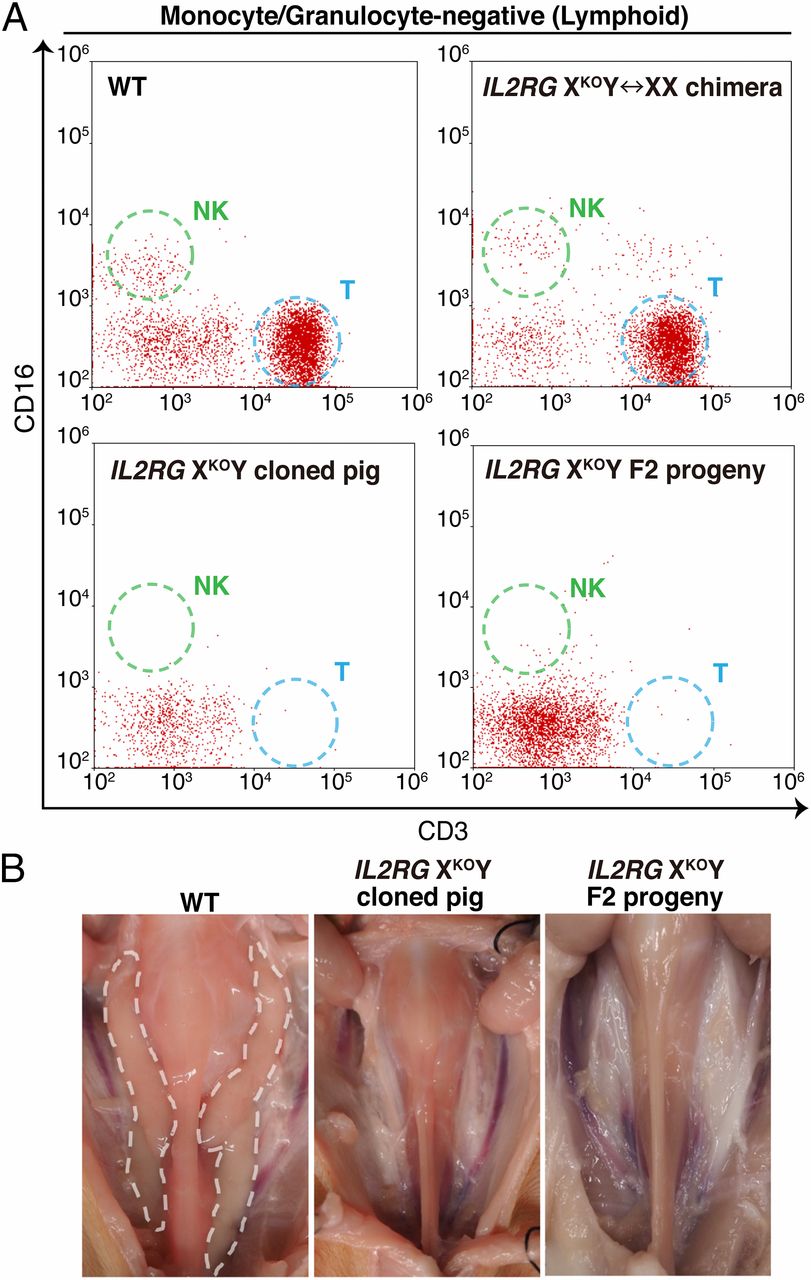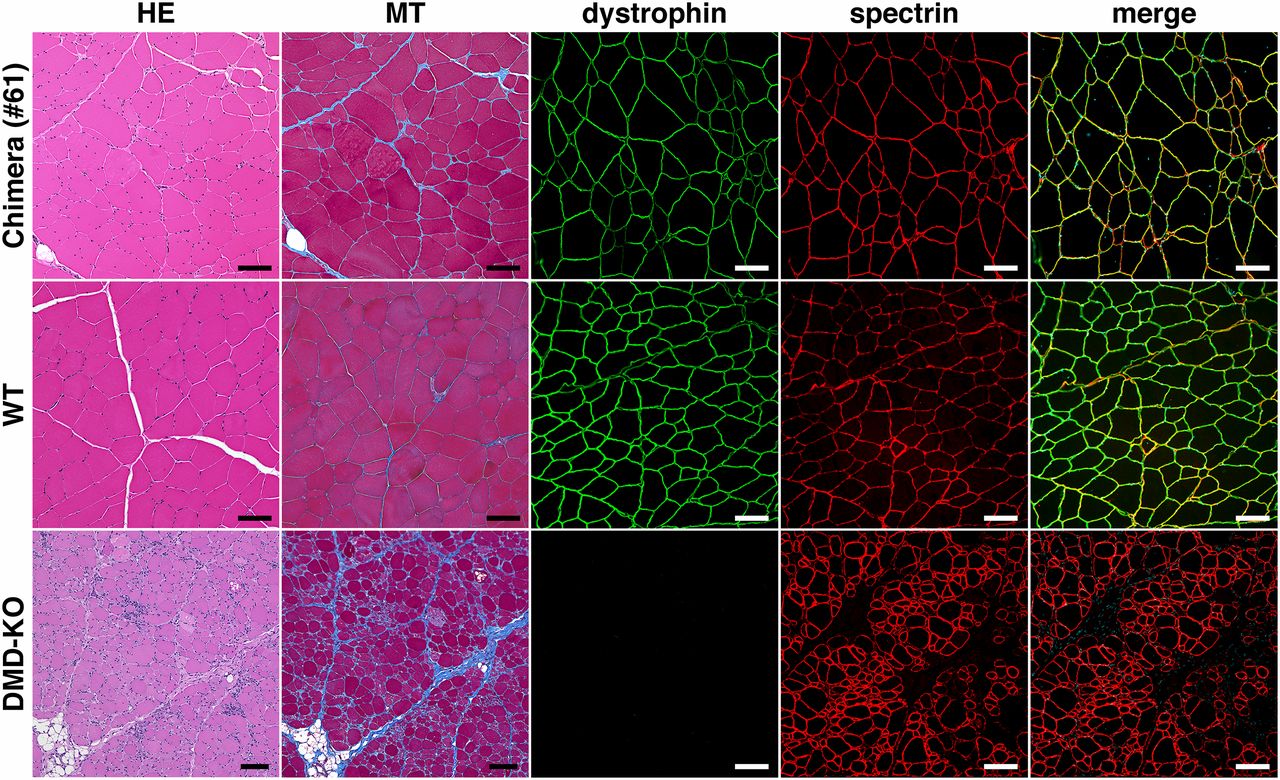Modeling lethal X-linked genetic disorders in pigs with ensured fertility
Matsunari H, Watanabe M, Nakano K, Enosawa S, Umeyama K, Uchikura A, Yashima S, Fukuda T, Klymiuk N, Kurome M, Kessler B, Wuensch A, Zakhartchenko V, Wolf E, Hanazono Y, Nagaya M, Umezawa A, Nakauchi H, Nagashima H., 08.01.2018
Abstract
Genetically engineered pigs play an indispensable role in the study of rare monogenic diseases. Pigs harboring a gene responsible for a specific disease can be efficiently generated via somatic cell cloning. The generation of somatic cell-cloned pigs from male cells with mutation(s) in an X chromosomal gene is a reliable and straightforward method for reproducing X-linked genetic diseases (XLGDs) in pigs. However, the severe symptoms of XLGDs are often accompanied by impaired growth and reproductive disorders, which hinder the reproduction of these valuable model animals. Here, we generated unique chimeric boars composed of mutant cells harboring a lethal XLGD and normal cells. The chimeric boars exhibited the cured phenotype with fertility while carrying and transmitting the genotype of the XLGD. This unique reproduction system permits routine production of XLGD model pigs through the male-based breeding, thereby opening an avenue for translational research using disease model pigs.
Matsunari H, Watanabe M, Nakano K, Enosawa S, Umeyama K, Uchikura A, Yashima S, Fukuda T, Klymiuk N, Kurome M, Kessler B, Wuensch A, Zakhartchenko V, Wolf E, Hanazono Y, Nagaya M, Umezawa A, Nakauchi H, Nagashima H. Modeling lethal X-linked genetic disorders in pigs with ensured fertility. Proc Natl Acad Sci U S A. 2018 Jan 23;115(4):708-713. doi: 10.1073/pnas.1715940115. Epub 2018 Jan 8. PMID: 29311328; PMCID: PMC5789933.
Publication: https://www.pnas.org/doi/full/10.1073/pnas.1715940115
 Disclaimer
Disclaimer
The publication Modeling lethal X-linked genetic disorders in pigs with ensured fertility by Matsunari H, Watanabe M, Nakano K, Enosawa S, Umeyama K, Uchikura A, Yashima S, Fukuda T, Klymiuk N, Kurome M, Kessler B, Wuensch A, Zakhartchenko V, Wolf E, Hanazono Y, Nagaya M, Umezawa A, Nakauchi H, Nagashima H. is published under an open access license: https://creativecommons.org/licenses/by-nc/4.0/. Permits non-commercial re-use, distribution, and reproduction in any medium, provided the original work is properly cited.
Curation by the MFGA team Relevant data sets presented in the publication have been identified. If possible, annotations (title, general information, conditions, processed tissue types and processed cell types) have been added based on information from the publication. Data tables and images that provide a good overview on the publication's findings on the data set have been extracted from the publication and/or supplement. If not stated otherwise, images are depicted with title and description exactly as in the publication. Tables have been adjusted to the MFGA table format. Conducted adjustments are explained in the detailed view of the tables. However, titles and descriptions have been adopted from the publication.
Data set 1: Transmission of the Mutant Trait to Offspring
Other: Other
Species
| Species |
|---|
| Pig |
Images

Fig. 2. Phenotype of the IL2RG -XKOY and IL2RG XKOY ↔ XWTXWT chimeric pig
(A) Flow cytometric analysis of the IL2RG XKOY ↔ XWTXWT chimeric pig. Flow cytometric analysis of the peripheral blood of a WT and IL2RG XKOY ↔ XWTXWT chimeric boar demonstrated restoration of the T and NK cell populations, which were absent in the cloned IL2RG XKOY pigs. The F2 IL2RG XKOY progeny of the IL2RG XKOY ↔ XWTXWT chimeric boar exhibited the same phenotype as the founder IL2RG XKOY cloned pigs. The dot plots show CD3 and CD16 [in the nonmyeloid fraction, i.e., monocyte/granulocyte (M/G)-negative] cells, indicating the differentiation of the T cell and NK cell subpopulations, respectively. (B) Macroscopic observation of thymi in the IL2RG -XKOY pigs. Athymic phenotype of the IL2RG -XKOY cloned pig was inherited by the F2 progeny obtained through sexual reproduction of the IL2RG XKOY ↔ XWTXWT chimeric boar.
Licensed under: https://creativecommons.org/licenses/by-nc/4.0/
Data set 2: Phenotypic Features of the Chimeric Pigs Carrying the Mutant Gene
Other: Other
Species
| Species |
|---|
| Pig |
Images

Fig. 3. Histological features of the muscle tissue of the DMD XKOY ↔ XWTXWT chimeric pig
Histological and immunofluorescence analysis of the biceps femoris muscle tissue of the chimeric, WT, and DMD-KO pigs. HE, hematoxylin and eosin staining; MT, Masson’s trichrome staining. HE and MT staining indicated that a large portion of the muscle tissue of the DMD XKOY ↔ XWTXWT chimera was composed of relatively uniform muscle fibers compared with the tissue of an age-matched WT pig. Histological analysis of the DMD-KO clones revealed regressive changes in the muscle tissue, including excessive variation of fiber diameter and regeneration/necrosis of fibers, as shown in our previous study (10). Immunofluorescence analysis demonstrated an extensive distribution of dystrophin-positive fibers in the muscle tissue of the DMD XKOY ↔ XWTXWT chimera, although the fibers were accompanied by slight variations in size. (Scale bars: 100 μm.)
Licensed under: https://creativecommons.org/licenses/by-nc/4.0/

Table 1
Licensed under: https://creativecommons.org/licenses/by-nc/4.0/
